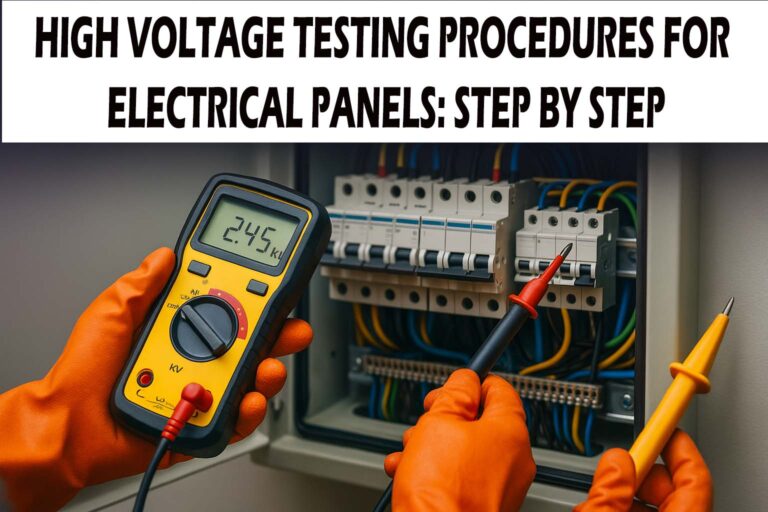Residual Current Devices Examples: How They Work and Why You Need Them
Residual current devices (RCDs) are essential safety components in electrical systems. They protect people from electric shocks and prevent electrical fires caused by leakage currents. Understanding different residual current devices examples helps in choosing the right one for homes, industries, and commercial buildings.

Table of Contents
Table of Contents
What is Residual Current and How It Arises?
Residual current refers to the leakage of electric current from a live conductor to the ground. It occurs when insulation fails, wires get damaged, or a person accidentally comes into contact with a live wire. If this current exceeds safe levels, it can cause serious injuries or fires.
Residual Current Device On or Off – Understanding Its Operation
An RCD (Residual Current Device) constantly monitors the current flowing through a circuit. If it detects an imbalance between the live and neutral wires, it immediately trips, cutting off the power. The residual current device on or off status depends on whether it has detected a leakage.
- ON Position: The RCD is active, allowing current to flow normally.
- OFF Position: The RCD has tripped due to leakage, disconnecting the power supply.
Regular testing ensures that the RCD functions correctly. A test button on the device helps simulate a fault condition to check if it trips as expected.
Residual Current Circuit Breaker and Its Working
A residual current circuit breaker (RCCB) is a specific type of RCD designed to trip when it detects leakage current. It does not provide protection against overcurrent or short circuits, so it is often used alongside miniature circuit breakers (MCBs).
Residual Current Circuit Breaker – How It Works?
The RCCB works on the principle of Kirchhoff’s Current Law, which states that the sum of currents entering a circuit must equal the sum of currents leaving. Inside the RCCB, a toroidal transformer detects differences in current between the live and neutral conductors.
- If the difference is within safe limits, the RCCB remains ON.
- If leakage occurs due to insulation failure or human contact, the imbalance triggers the device to trip.
This prevents electrocution and fire hazards, making RCCBs a crucial part of modern electrical safety.
Residual Current Devices Examples in Practical Applications
There are several types of residual current devices used in different environments.
1. Portable Residual Current Devices
- Used in outdoor activities, construction sites, and temporary power setups.
- Plugged into sockets to provide protection for connected appliances.
2. Fixed Residual Current Devices
- Installed in homes, offices, and industrial buildings.
- Provide continuous protection for all connected circuits.
3. Residual Current Breakers with Overcurrent (RCBOs)
- Combine the function of an RCCB and an MCB.
- Protect against leakage current and short circuits in one device.
4. High-Sensitivity RCDs (10mA – 30mA Rating)
- Used in residential buildings and medical facilities.
- Provides enhanced protection against electric shocks.
5. Low-Sensitivity RCDs (100mA – 300mA Rating)
- Installed in industrial setups to prevent fire hazards.
RCD Full Form in Electrical and Its Meaning
The RCD full form in electrical is Residual Current Device. It is also called an Earth Leakage Circuit Breaker (ELCB) in some regions.
RCD Meaning in Simple Terms
An RCD is a safety switch that cuts off electricity when it detects a leakage current. Unlike normal fuses or circuit breakers, RCDs respond to small leakages that can be fatal.
How Does an RCD Work?
An RCD continuously compares the current flowing in the live and neutral wires. Under normal conditions, both currents are equal. If there is a leakage due to a fault, the imbalance triggers the RCD to switch off power.
Choosing the Right Residual Current Device – RCD Price and Factors
The RCD price depends on various factors, including:
- Current rating (16A, 25A, 40A, 63A, etc.)
- Sensitivity (10mA, 30mA, 100mA, 300mA, etc.)
- Type (Fixed, Portable, RCBO, etc.)
- Brand and country of manufacture
A basic 30mA RCCB for home use typically costs between $10 and $50, while RCBOs and industrial-grade RCDs can be more expensive.
Residual Current Devices vs. Miniature Current Circuit Breakers
A miniature current circuit breaker (MCB) protects against overloads and short circuits. However, it does not detect leakage currents. That’s why residual current devices examples include RCCBs, RCBOs, and portable RCDs, which provide additional safety.
Why Every Home and Workplace Needs RCDs?
- Prevents Electrocution: Stops fatal shocks by disconnecting power.
- Reduces Fire Risk: Detects small leakage currents before they cause overheating.
- Complies with Electrical Safety Standards: Mandatory in many countries.
- Protects Sensitive Equipment: Prevents electrical damage to appliances.
Conclusion
Understanding different residual current devices examples helps in selecting the right protection for homes, workplaces, and industrial sites. Whether it is an RCCB, RCBO, or a portable RCD, these devices play a vital role in electrical safety.
For more information on what is residual current, its effects, and safety measures, explore our in-depth resources on electrical protection.
Is RCD the same as GFCI?
Yes, an RCD (Residual Current Device) and a GFCI (Ground Fault Circuit Interrupter) serve the same purpose—they both detect leakage currents and prevent electric shocks. RCD is the term used in the UK and other regions, while GFCI is commonly used in North America.
What is an example of using an RCD?
A common example is using an RCD in bathrooms or outdoor sockets to prevent electric shocks when using electrical appliances near water, such as a hairdryer or lawnmower.
What is the difference between SPD and RCD?
An SPD (Surge Protection Device) protects against voltage spikes from lightning or power surges, while an RCD prevents electric shocks by cutting power when it detects a leakage current. They serve different safety functions.
What is the most common type of RCD?
The most common type is a 30mA RCD, which provides personal protection against electric shocks and is typically used in homes and workplaces.
Is a breaker an RCD?
No, a breaker (MCB) protects against overloads and short circuits, while an RCD detects leakage currents to prevent electrocution. However, an RCBO combines both functions in one device.
What circuits need an RCD?
Circuits for bathrooms, kitchens, outdoor sockets, and any circuit supplying portable appliances or equipment in wet areas require an RCD for safety. In many countries, all socket outlets must be RCD-protected.
Follow Us on Social:
Subscribe our Newsletter on Electrical Insights for latest updates from Electrical Engineering Hub
ResidualCurrentDevice, #RCDProtection, #ElectricalSafety, #CircuitBreaker, #ShockProtection, #GroundFault, #ElectricalHazards, #RCDTesting, #HomeSafety, #ElectricalEngineering, #PowerProtection, #EarthLeakage, #RCDSwitch, #SafetyFirst, #ElectricalMaintenance





